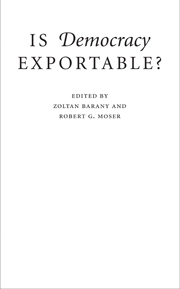Book contents
- Frontmatter
- Contents
- Contributors
- Acknowledgments
- Introduction
- A MORAL IMPERATIVE?
- STRUCTURAL PRECONDITIONS
- INSTITUTIONS AND PROCESSES
- 6 Electoral Engineering in New Democracies: Can Preferred Electoral Outcomes Be Engineered?
- 7 Does It Matter How a Constitution Is Created?
- 8 Building Democratic Armies
- 9 Democratization, Conflict, and Trade
- 10 Exporting Democracy: Does It Work?
- Conclusion: Is Democracy Exportable?
- Bibliography
- Index
8 - Building Democratic Armies
Published online by Cambridge University Press: 05 June 2012
- Frontmatter
- Contents
- Contributors
- Acknowledgments
- Introduction
- A MORAL IMPERATIVE?
- STRUCTURAL PRECONDITIONS
- INSTITUTIONS AND PROCESSES
- 6 Electoral Engineering in New Democracies: Can Preferred Electoral Outcomes Be Engineered?
- 7 Does It Matter How a Constitution Is Created?
- 8 Building Democratic Armies
- 9 Democratization, Conflict, and Trade
- 10 Exporting Democracy: Does It Work?
- Conclusion: Is Democracy Exportable?
- Bibliography
- Index
Summary
The principal foundations on which the power of all governments is based (whether they be new, long-established or mixed) are good laws and good armies.
Machiavelli, The Prince (1995: 38)A secure environment in which the public need not fear physical violence is an indispensable prerequisite of democracy building. Having a reliable and competent police force is obviously a crucial part of providing public safety. Ultimately, however, the most critical institution a democratizing state must establish that will allow the police to do their work in the first place is the regular armed forces. Where there is widespread violence and/or armed conflict, the police ordinarily lack the capacity to normalize the situation and only a conventional army can bring about a stable environment. This seems to be a straightforward proposition, but democratization and democracy-promotion scholars seldom acknowledge that the projects of democratization cannot proceed without basic, street-level public safety.
Hundreds of books have been written on virtually every conceivable aspect of democratization, but the question of how democratic armies – that is to say, armies supportive of democratic governance (not of one or another political party) – might be molded in post-authoritarian states has received surprisingly little attention. This is a curious omission because – as has become all too clear in Iraq – it is virtually impossible to get on with the various political, social, and economic projects of democracy-building without establishing physical security.
- Type
- Chapter
- Information
- Is Democracy Exportable? , pp. 178 - 204Publisher: Cambridge University PressPrint publication year: 2009
- 1
- Cited by



